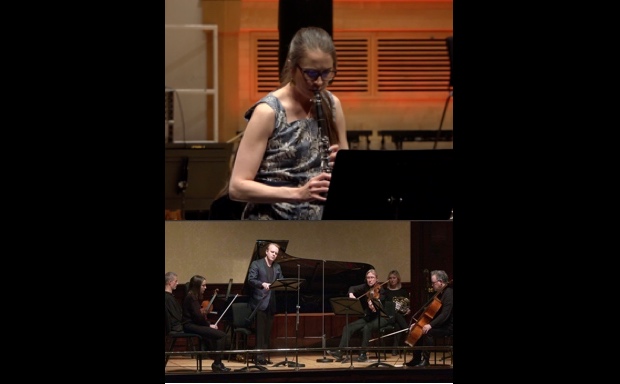Natura Naturans II (Wigmore Hall - 12/10/22)

I'm very grateful to the wonderful Apartment House ensemble for requesting a follow-up of my clarinet concerto Natura Naturans for chamber forces. They play it at the Wigmore Hall (London) on Wednesday 12 October 2022 7:30PM alongside works by Jack Sheen, Jeney, Juta Pranulytė, and Oliver Leith.
The new version is for Heather Roche (clarinet solo) with 2 violin, 2 viola, 2 cello, with both cellos and one viola using wooden preparations. See here for a blog post on the original piece, but this is a substantial reduction from the original piece's string orchestra, and changes the focus somewhat from a mass/cluster texture to something more focussed. However, the advantage is that these string players are more specialised in the techniques used here, which is magnified by the chamber setting affording greater detail and focus of listening. Specifically, the strings use a harmonic glissando technique derived from John Lely's seminal piece The Harmonics of Real Strings, a piece well known to Apartment House; it has been performed extensively by both Anton Lukoszevieze and Mira Benjamin, both of whom are playing in this concert. The focus (see below) is on slow movement along the string and allowing (slightly) indeterminate harmonics to emerge in their own time, supporting and foregrounding them as they emerge. This new version allows for more focussed listening and chamber-like interaction between both strings and clarinet solo.

The string preparations (example here) are also reduced in number but afforded more focus in the chamber context. The orchestra version was 6 cellos and 4 basses, and as above it was largely about focus on a probable 'G' emerging, but with a cloud of other indeterminate pitches emerging. The cloud was maximised by using different strings and different positions across the 10 instruments, so it was 10* different resonant bodies but united by the preparations favouring a sounding 'G' (in varying octaves). In the chamber version, it was tricky to keep both the prepared and non-prepared aspect of the low strings part in only 2 prepared cellos, but I managed it so that both are positioned for a sounding G3, but cello-1 prepares strings III/IV, and cello-2 prepares strings II/III: the preparations couple two strings together, and those strings are then useless for 'normal' pitch production.
I'm extremely excited to hear this new piece in such a different mode of performance.
* I managed to avoid duplication mostly (see b.1 of original score for preparation placements/strings), so it was really 8 different resonant bodies, but the very loose coordination between players meant that even the duplicated positions were unlikely to be playing exactly the same position/pressure/speed/etc at the same moment.
